Error analysis of an English learner
VerifiedAdded on 2023/06/05
|16
|5103
|73
AI Summary
This article discusses the errors made by an Arabic-speaking English learner in question formation and sentence construction. It also provides teaching activities to address these errors. The learner's background, learning circumstances, and communicative aims are also mentioned.
Contribute Materials
Your contribution can guide someone’s learning journey. Share your
documents today.
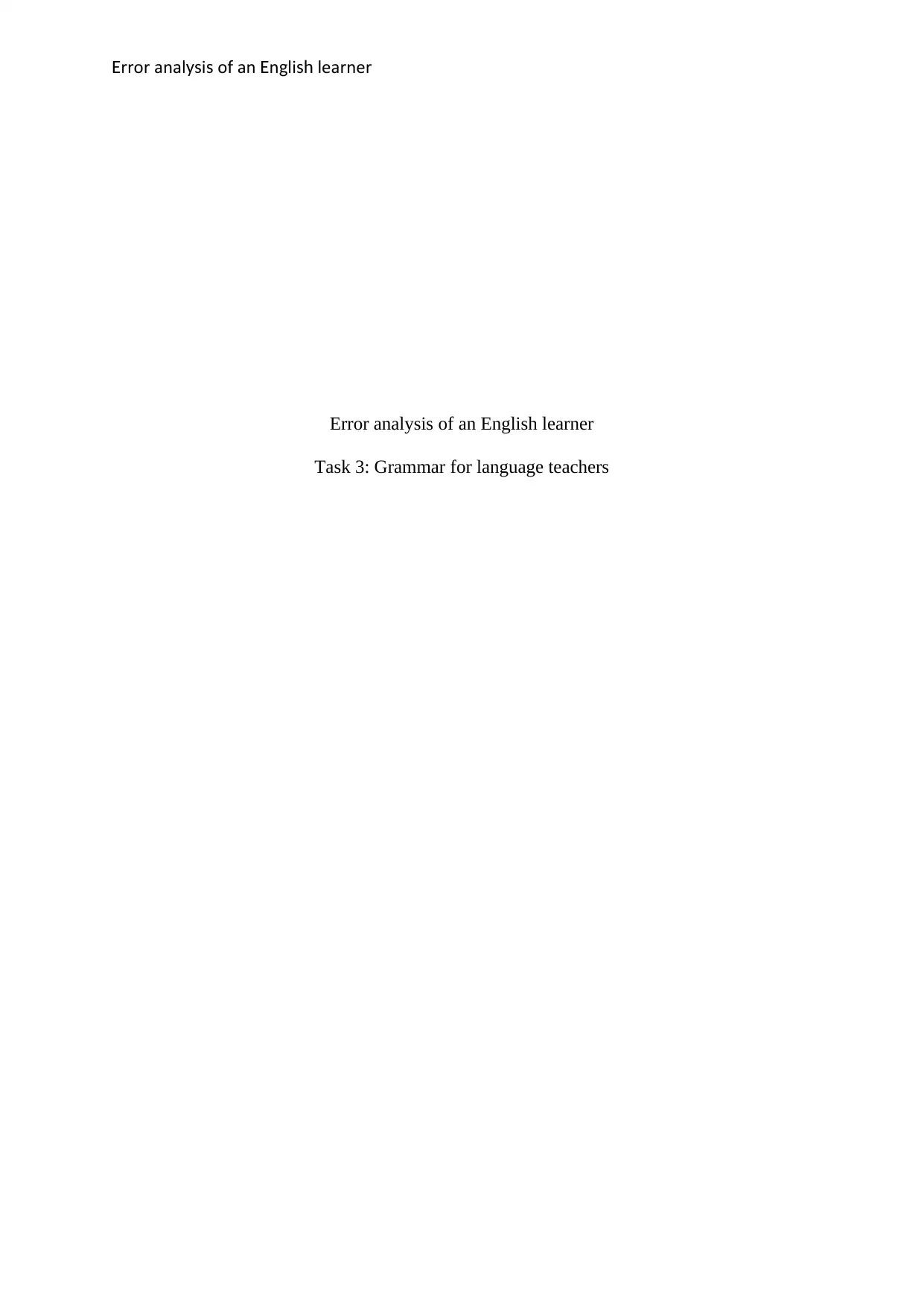
rror anal i o an n li learnerE ys s f E g sh
Error analysis of an English learner
Task 3: Grammar for language teachers
Error analysis of an English learner
Task 3: Grammar for language teachers
Secure Best Marks with AI Grader
Need help grading? Try our AI Grader for instant feedback on your assignments.

rror anal i o an n li learnerE ys s f E g sh
PART 1
Introduction to the learner
Mention the learner’s L1, previous experience of learning and using the target language
and other languages. Also mention their learning circumstances and their plans for the
future, including how proficiency in the target language is involved in these plans. What
are the communicative aims and needs of your learner?
L1 is a student by a pseudonym Salim, Arabic is his first language and he is trying to learn
and speak English as his second language. His main difficulties in the target language are the
constructing of the sentences and the correct use of vocabulary (Smith, 2001). He has
completed the necessary stages of studying English; however, he still has a problem of failing
to follow the rules of the language. For example, the order of words, pronunciation and using
articles. The learning circumstances are quite delicate since the first language the learner has
grown up speaking and understanding is Arabic. It has influenced his sentence construction
due to the fact that there are structural and grammatical differences between the two
languages. There are some mistakes that he is making like, the wrong use of vocabularies,
wrong pronunciation of words among others. Salim would like to become an English teacher
after completing his studies, and he gets this inspiration from his cousin who teaches in a
different country. For him to teach or become an English teacher, he must be proficient in the
target language. The aims of communication for Salim includes being able to start a
conversation, being able to take turns, being able to end a dialogue, and also the ability to use
various terms and sentence structures correctly.
PART 1
Introduction to the learner
Mention the learner’s L1, previous experience of learning and using the target language
and other languages. Also mention their learning circumstances and their plans for the
future, including how proficiency in the target language is involved in these plans. What
are the communicative aims and needs of your learner?
L1 is a student by a pseudonym Salim, Arabic is his first language and he is trying to learn
and speak English as his second language. His main difficulties in the target language are the
constructing of the sentences and the correct use of vocabulary (Smith, 2001). He has
completed the necessary stages of studying English; however, he still has a problem of failing
to follow the rules of the language. For example, the order of words, pronunciation and using
articles. The learning circumstances are quite delicate since the first language the learner has
grown up speaking and understanding is Arabic. It has influenced his sentence construction
due to the fact that there are structural and grammatical differences between the two
languages. There are some mistakes that he is making like, the wrong use of vocabularies,
wrong pronunciation of words among others. Salim would like to become an English teacher
after completing his studies, and he gets this inspiration from his cousin who teaches in a
different country. For him to teach or become an English teacher, he must be proficient in the
target language. The aims of communication for Salim includes being able to start a
conversation, being able to take turns, being able to end a dialogue, and also the ability to use
various terms and sentence structures correctly.

rror anal i o an n li learnerE ys s f E g sh
What are the three language features (mistakes/errors) you will analyse - Why have
these been chosen?
1. The structure of questions. The use of questions is essential in communication, for
example, it helps when one desires to make requests clear or allow others also to participate
in a conversation.
2. Mistakes in forming sentences. When a learner makes this mistake, the sentence changes
its meaning.
3. The use of articles. The learner should understand how the articles work and how to use
them in a sentence.
PART 2
Learner data feature 1 (vocabulary or phrase level): Question formation
Describe and explain the learner’s mistake/error in terms of Form, Meaning and Use,
using examples?
There are many questions that Salim has used which are incorrect in terms of their form,
meaning and use.
Form
What you think about this?
What the rules I should follow?
It is simple to learn or no?
In the first question "What you think about this? “The correct form should be as follows.
"What do you think about this?" instead of "What you think about this?"
In his question structure, the auxiliary verb "do" is missing which changes the form of the
question making it incorrect. The sentence has a subject "you" which qualifies the sentence to
What are the three language features (mistakes/errors) you will analyse - Why have
these been chosen?
1. The structure of questions. The use of questions is essential in communication, for
example, it helps when one desires to make requests clear or allow others also to participate
in a conversation.
2. Mistakes in forming sentences. When a learner makes this mistake, the sentence changes
its meaning.
3. The use of articles. The learner should understand how the articles work and how to use
them in a sentence.
PART 2
Learner data feature 1 (vocabulary or phrase level): Question formation
Describe and explain the learner’s mistake/error in terms of Form, Meaning and Use,
using examples?
There are many questions that Salim has used which are incorrect in terms of their form,
meaning and use.
Form
What you think about this?
What the rules I should follow?
It is simple to learn or no?
In the first question "What you think about this? “The correct form should be as follows.
"What do you think about this?" instead of "What you think about this?"
In his question structure, the auxiliary verb "do" is missing which changes the form of the
question making it incorrect. The sentence has a subject "you" which qualifies the sentence to
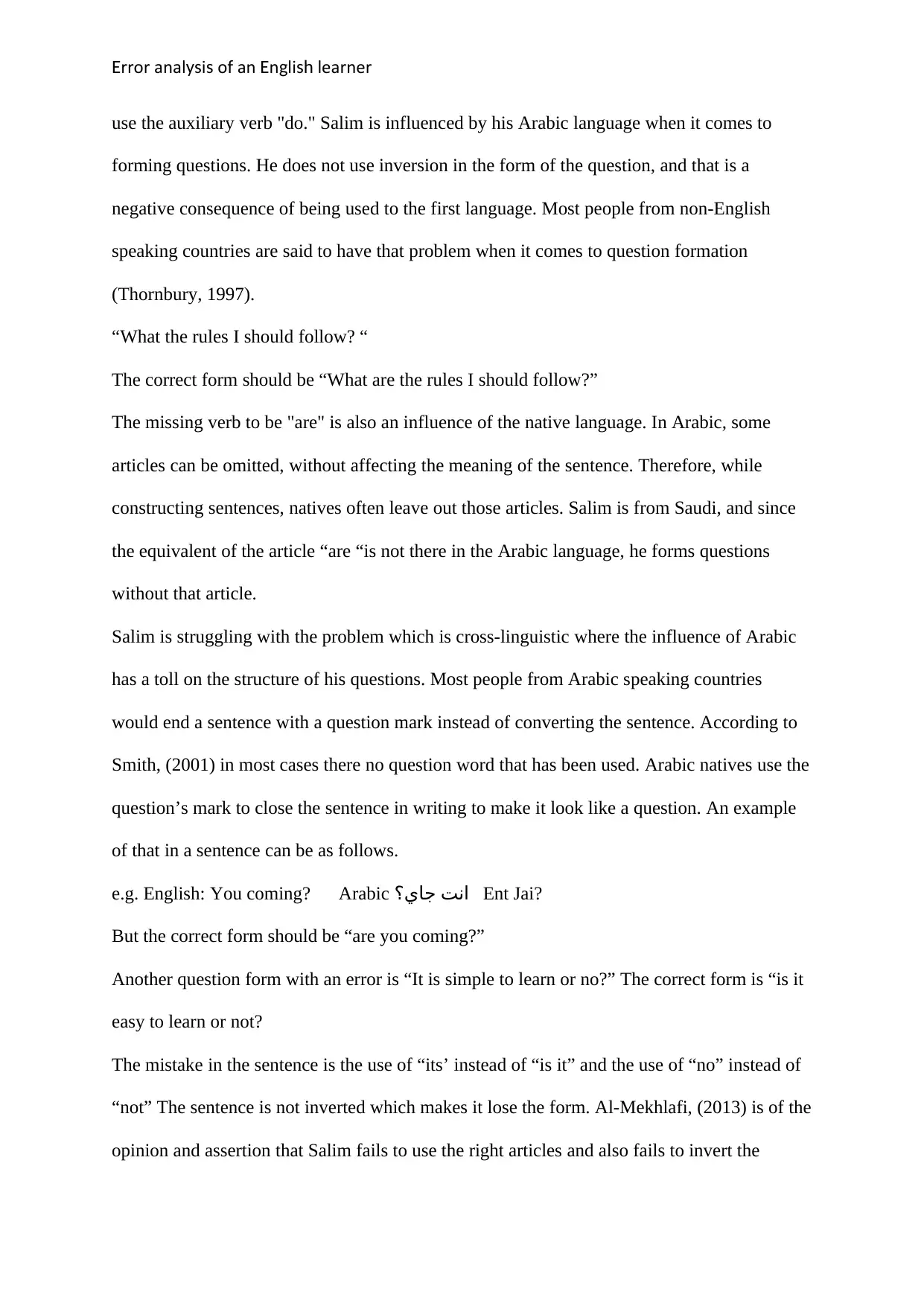
rror anal i o an n li learnerE ys s f E g sh
use the auxiliary verb "do." Salim is influenced by his Arabic language when it comes to
forming questions. He does not use inversion in the form of the question, and that is a
negative consequence of being used to the first language. Most people from non-English
speaking countries are said to have that problem when it comes to question formation
(Thornbury, 1997).
“What the rules I should follow? “
The correct form should be “What are the rules I should follow?”
The missing verb to be "are" is also an influence of the native language. In Arabic, some
articles can be omitted, without affecting the meaning of the sentence. Therefore, while
constructing sentences, natives often leave out those articles. Salim is from Saudi, and since
the equivalent of the article “are “is not there in the Arabic language, he forms questions
without that article.
Salim is struggling with the problem which is cross-linguistic where the influence of Arabic
has a toll on the structure of his questions. Most people from Arabic speaking countries
would end a sentence with a question mark instead of converting the sentence. According to
Smith, (2001) in most cases there no question word that has been used. Arabic natives use the
question’s mark to close the sentence in writing to make it look like a question. An example
of that in a sentence can be as follows.
e.g. English: You coming? Arabic انت جاي؟ Ent Jai?
But the correct form should be “are you coming?”
Another question form with an error is “It is simple to learn or no?” The correct form is “is it
easy to learn or not?
The mistake in the sentence is the use of “its’ instead of “is it” and the use of “no” instead of
“not” The sentence is not inverted which makes it lose the form. Al-Mekhlafi, (2013) is of the
opinion and assertion that Salim fails to use the right articles and also fails to invert the
use the auxiliary verb "do." Salim is influenced by his Arabic language when it comes to
forming questions. He does not use inversion in the form of the question, and that is a
negative consequence of being used to the first language. Most people from non-English
speaking countries are said to have that problem when it comes to question formation
(Thornbury, 1997).
“What the rules I should follow? “
The correct form should be “What are the rules I should follow?”
The missing verb to be "are" is also an influence of the native language. In Arabic, some
articles can be omitted, without affecting the meaning of the sentence. Therefore, while
constructing sentences, natives often leave out those articles. Salim is from Saudi, and since
the equivalent of the article “are “is not there in the Arabic language, he forms questions
without that article.
Salim is struggling with the problem which is cross-linguistic where the influence of Arabic
has a toll on the structure of his questions. Most people from Arabic speaking countries
would end a sentence with a question mark instead of converting the sentence. According to
Smith, (2001) in most cases there no question word that has been used. Arabic natives use the
question’s mark to close the sentence in writing to make it look like a question. An example
of that in a sentence can be as follows.
e.g. English: You coming? Arabic انت جاي؟ Ent Jai?
But the correct form should be “are you coming?”
Another question form with an error is “It is simple to learn or no?” The correct form is “is it
easy to learn or not?
The mistake in the sentence is the use of “its’ instead of “is it” and the use of “no” instead of
“not” The sentence is not inverted which makes it lose the form. Al-Mekhlafi, (2013) is of the
opinion and assertion that Salim fails to use the right articles and also fails to invert the
Secure Best Marks with AI Grader
Need help grading? Try our AI Grader for instant feedback on your assignments.
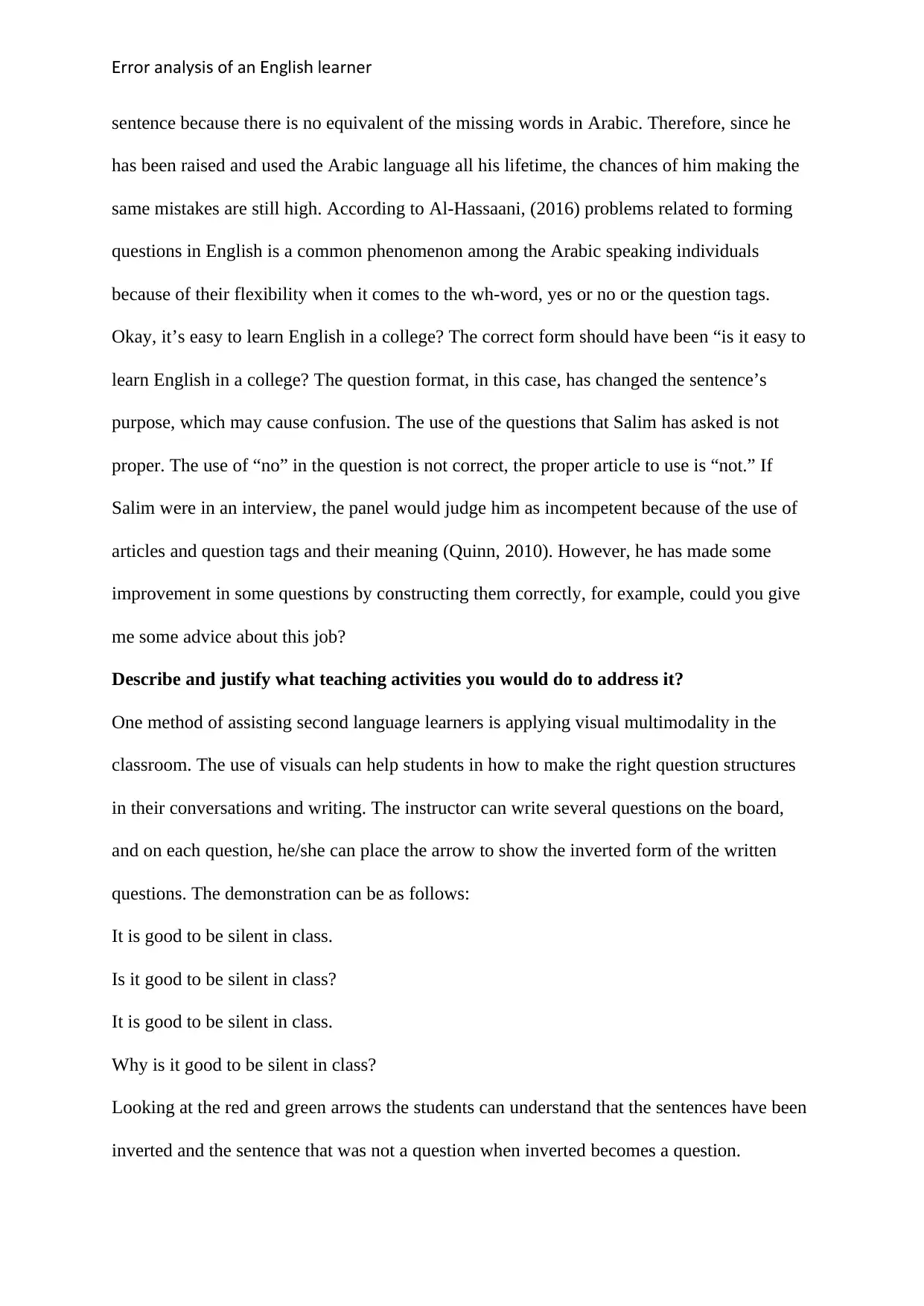
rror anal i o an n li learnerE ys s f E g sh
sentence because there is no equivalent of the missing words in Arabic. Therefore, since he
has been raised and used the Arabic language all his lifetime, the chances of him making the
same mistakes are still high. According to Al-Hassaani, (2016) problems related to forming
questions in English is a common phenomenon among the Arabic speaking individuals
because of their flexibility when it comes to the wh-word, yes or no or the question tags.
Okay, it’s easy to learn English in a college? The correct form should have been “is it easy to
learn English in a college? The question format, in this case, has changed the sentence’s
purpose, which may cause confusion. The use of the questions that Salim has asked is not
proper. The use of “no” in the question is not correct, the proper article to use is “not.” If
Salim were in an interview, the panel would judge him as incompetent because of the use of
articles and question tags and their meaning (Quinn, 2010). However, he has made some
improvement in some questions by constructing them correctly, for example, could you give
me some advice about this job?
Describe and justify what teaching activities you would do to address it?
One method of assisting second language learners is applying visual multimodality in the
classroom. The use of visuals can help students in how to make the right question structures
in their conversations and writing. The instructor can write several questions on the board,
and on each question, he/she can place the arrow to show the inverted form of the written
questions. The demonstration can be as follows:
It is good to be silent in class.
Is it good to be silent in class?
It is good to be silent in class.
Why is it good to be silent in class?
Looking at the red and green arrows the students can understand that the sentences have been
inverted and the sentence that was not a question when inverted becomes a question.
sentence because there is no equivalent of the missing words in Arabic. Therefore, since he
has been raised and used the Arabic language all his lifetime, the chances of him making the
same mistakes are still high. According to Al-Hassaani, (2016) problems related to forming
questions in English is a common phenomenon among the Arabic speaking individuals
because of their flexibility when it comes to the wh-word, yes or no or the question tags.
Okay, it’s easy to learn English in a college? The correct form should have been “is it easy to
learn English in a college? The question format, in this case, has changed the sentence’s
purpose, which may cause confusion. The use of the questions that Salim has asked is not
proper. The use of “no” in the question is not correct, the proper article to use is “not.” If
Salim were in an interview, the panel would judge him as incompetent because of the use of
articles and question tags and their meaning (Quinn, 2010). However, he has made some
improvement in some questions by constructing them correctly, for example, could you give
me some advice about this job?
Describe and justify what teaching activities you would do to address it?
One method of assisting second language learners is applying visual multimodality in the
classroom. The use of visuals can help students in how to make the right question structures
in their conversations and writing. The instructor can write several questions on the board,
and on each question, he/she can place the arrow to show the inverted form of the written
questions. The demonstration can be as follows:
It is good to be silent in class.
Is it good to be silent in class?
It is good to be silent in class.
Why is it good to be silent in class?
Looking at the red and green arrows the students can understand that the sentences have been
inverted and the sentence that was not a question when inverted becomes a question.
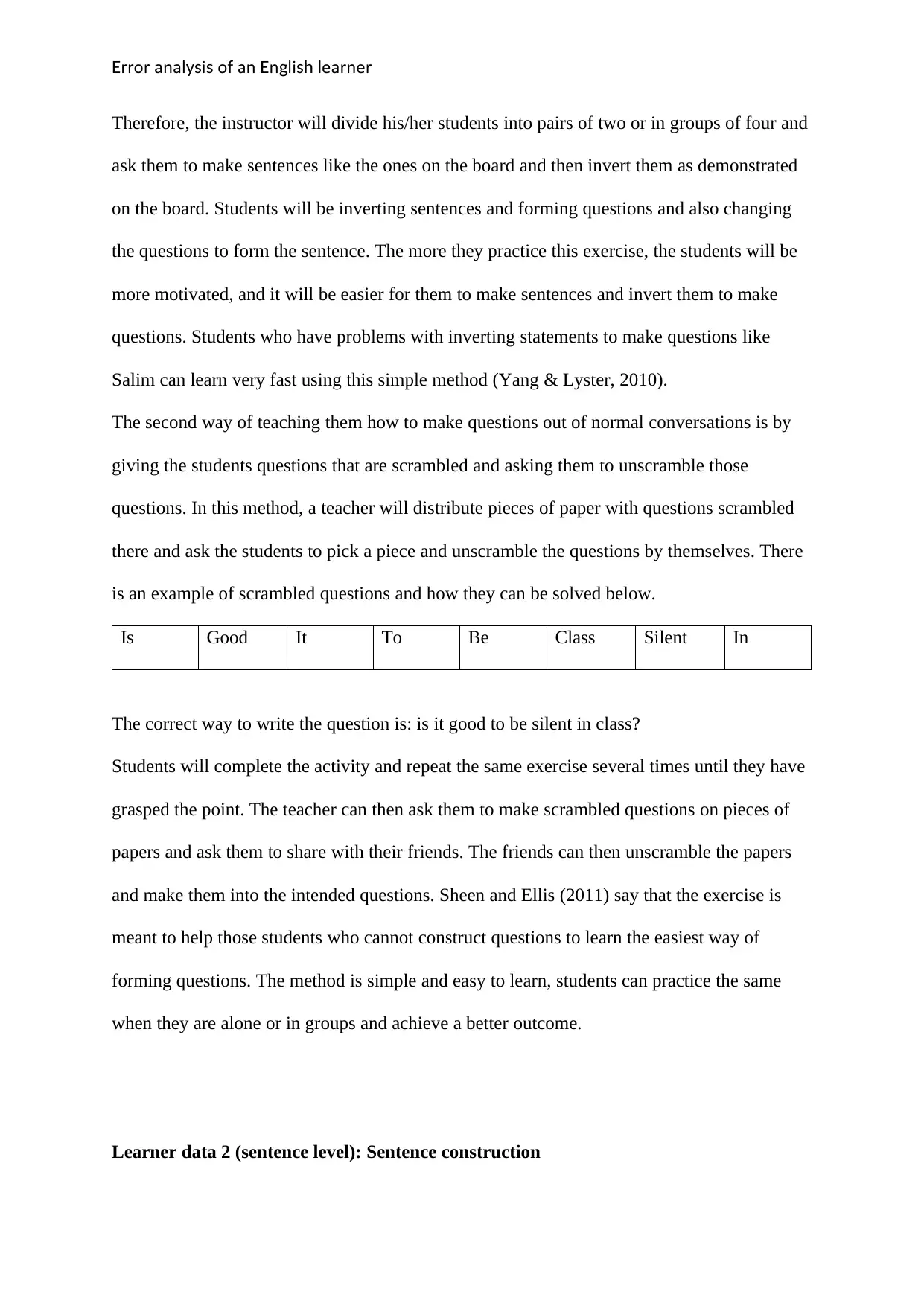
rror anal i o an n li learnerE ys s f E g sh
Therefore, the instructor will divide his/her students into pairs of two or in groups of four and
ask them to make sentences like the ones on the board and then invert them as demonstrated
on the board. Students will be inverting sentences and forming questions and also changing
the questions to form the sentence. The more they practice this exercise, the students will be
more motivated, and it will be easier for them to make sentences and invert them to make
questions. Students who have problems with inverting statements to make questions like
Salim can learn very fast using this simple method (Yang & Lyster, 2010).
The second way of teaching them how to make questions out of normal conversations is by
giving the students questions that are scrambled and asking them to unscramble those
questions. In this method, a teacher will distribute pieces of paper with questions scrambled
there and ask the students to pick a piece and unscramble the questions by themselves. There
is an example of scrambled questions and how they can be solved below.
Is Good It To Be Class Silent In
The correct way to write the question is: is it good to be silent in class?
Students will complete the activity and repeat the same exercise several times until they have
grasped the point. The teacher can then ask them to make scrambled questions on pieces of
papers and ask them to share with their friends. The friends can then unscramble the papers
and make them into the intended questions. Sheen and Ellis (2011) say that the exercise is
meant to help those students who cannot construct questions to learn the easiest way of
forming questions. The method is simple and easy to learn, students can practice the same
when they are alone or in groups and achieve a better outcome.
Learner data 2 (sentence level): Sentence construction
Therefore, the instructor will divide his/her students into pairs of two or in groups of four and
ask them to make sentences like the ones on the board and then invert them as demonstrated
on the board. Students will be inverting sentences and forming questions and also changing
the questions to form the sentence. The more they practice this exercise, the students will be
more motivated, and it will be easier for them to make sentences and invert them to make
questions. Students who have problems with inverting statements to make questions like
Salim can learn very fast using this simple method (Yang & Lyster, 2010).
The second way of teaching them how to make questions out of normal conversations is by
giving the students questions that are scrambled and asking them to unscramble those
questions. In this method, a teacher will distribute pieces of paper with questions scrambled
there and ask the students to pick a piece and unscramble the questions by themselves. There
is an example of scrambled questions and how they can be solved below.
Is Good It To Be Class Silent In
The correct way to write the question is: is it good to be silent in class?
Students will complete the activity and repeat the same exercise several times until they have
grasped the point. The teacher can then ask them to make scrambled questions on pieces of
papers and ask them to share with their friends. The friends can then unscramble the papers
and make them into the intended questions. Sheen and Ellis (2011) say that the exercise is
meant to help those students who cannot construct questions to learn the easiest way of
forming questions. The method is simple and easy to learn, students can practice the same
when they are alone or in groups and achieve a better outcome.
Learner data 2 (sentence level): Sentence construction
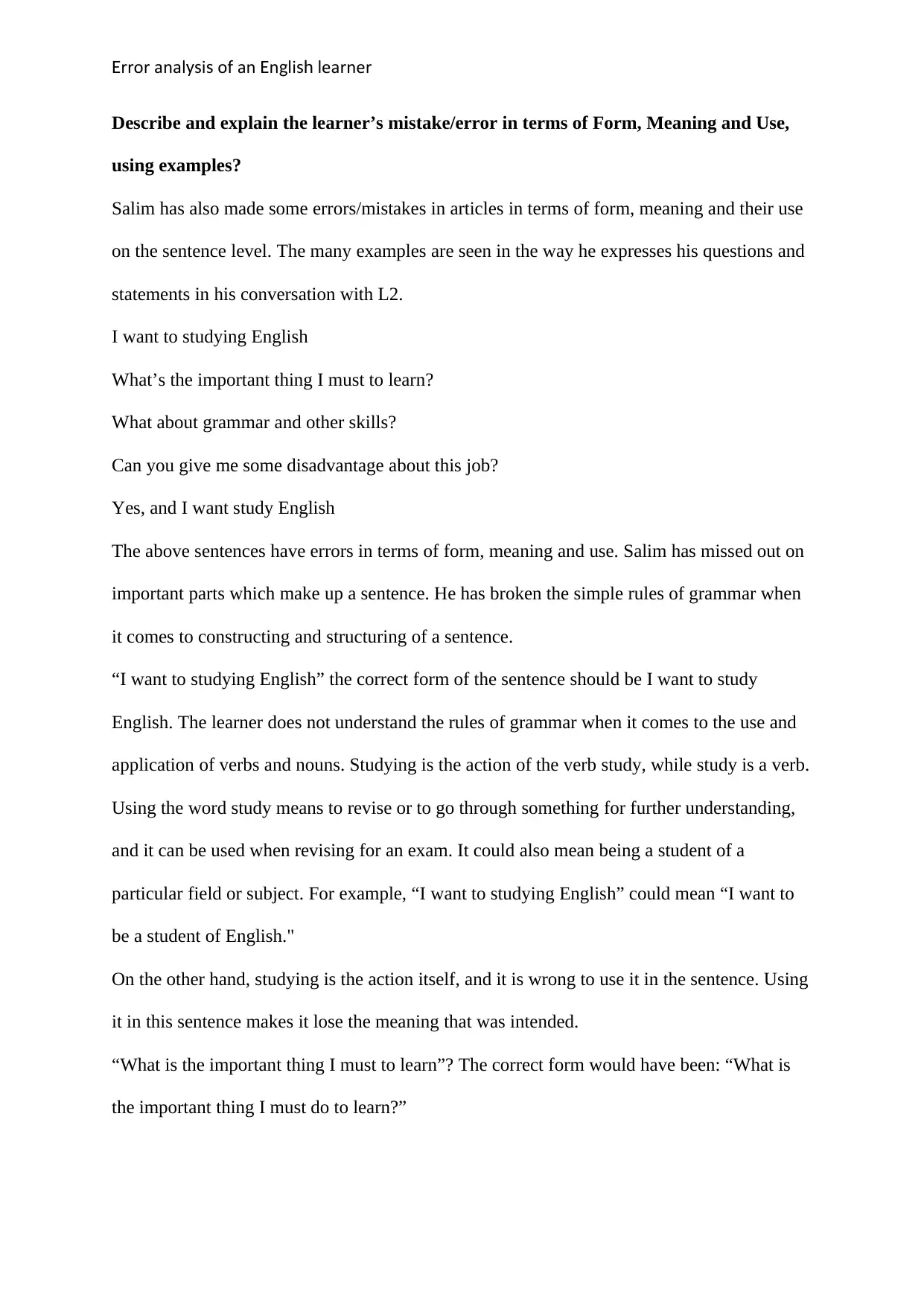
rror anal i o an n li learnerE ys s f E g sh
Describe and explain the learner’s mistake/error in terms of Form, Meaning and Use,
using examples?
Salim has also made some errors/mistakes in articles in terms of form, meaning and their use
on the sentence level. The many examples are seen in the way he expresses his questions and
statements in his conversation with L2.
I want to studying English
What’s the important thing I must to learn?
What about grammar and other skills?
Can you give me some disadvantage about this job?
Yes, and I want study English
The above sentences have errors in terms of form, meaning and use. Salim has missed out on
important parts which make up a sentence. He has broken the simple rules of grammar when
it comes to constructing and structuring of a sentence.
“I want to studying English” the correct form of the sentence should be I want to study
English. The learner does not understand the rules of grammar when it comes to the use and
application of verbs and nouns. Studying is the action of the verb study, while study is a verb.
Using the word study means to revise or to go through something for further understanding,
and it can be used when revising for an exam. It could also mean being a student of a
particular field or subject. For example, “I want to studying English” could mean “I want to
be a student of English."
On the other hand, studying is the action itself, and it is wrong to use it in the sentence. Using
it in this sentence makes it lose the meaning that was intended.
“What is the important thing I must to learn”? The correct form would have been: “What is
the important thing I must do to learn?”
Describe and explain the learner’s mistake/error in terms of Form, Meaning and Use,
using examples?
Salim has also made some errors/mistakes in articles in terms of form, meaning and their use
on the sentence level. The many examples are seen in the way he expresses his questions and
statements in his conversation with L2.
I want to studying English
What’s the important thing I must to learn?
What about grammar and other skills?
Can you give me some disadvantage about this job?
Yes, and I want study English
The above sentences have errors in terms of form, meaning and use. Salim has missed out on
important parts which make up a sentence. He has broken the simple rules of grammar when
it comes to constructing and structuring of a sentence.
“I want to studying English” the correct form of the sentence should be I want to study
English. The learner does not understand the rules of grammar when it comes to the use and
application of verbs and nouns. Studying is the action of the verb study, while study is a verb.
Using the word study means to revise or to go through something for further understanding,
and it can be used when revising for an exam. It could also mean being a student of a
particular field or subject. For example, “I want to studying English” could mean “I want to
be a student of English."
On the other hand, studying is the action itself, and it is wrong to use it in the sentence. Using
it in this sentence makes it lose the meaning that was intended.
“What is the important thing I must to learn”? The correct form would have been: “What is
the important thing I must do to learn?”
Paraphrase This Document
Need a fresh take? Get an instant paraphrase of this document with our AI Paraphraser
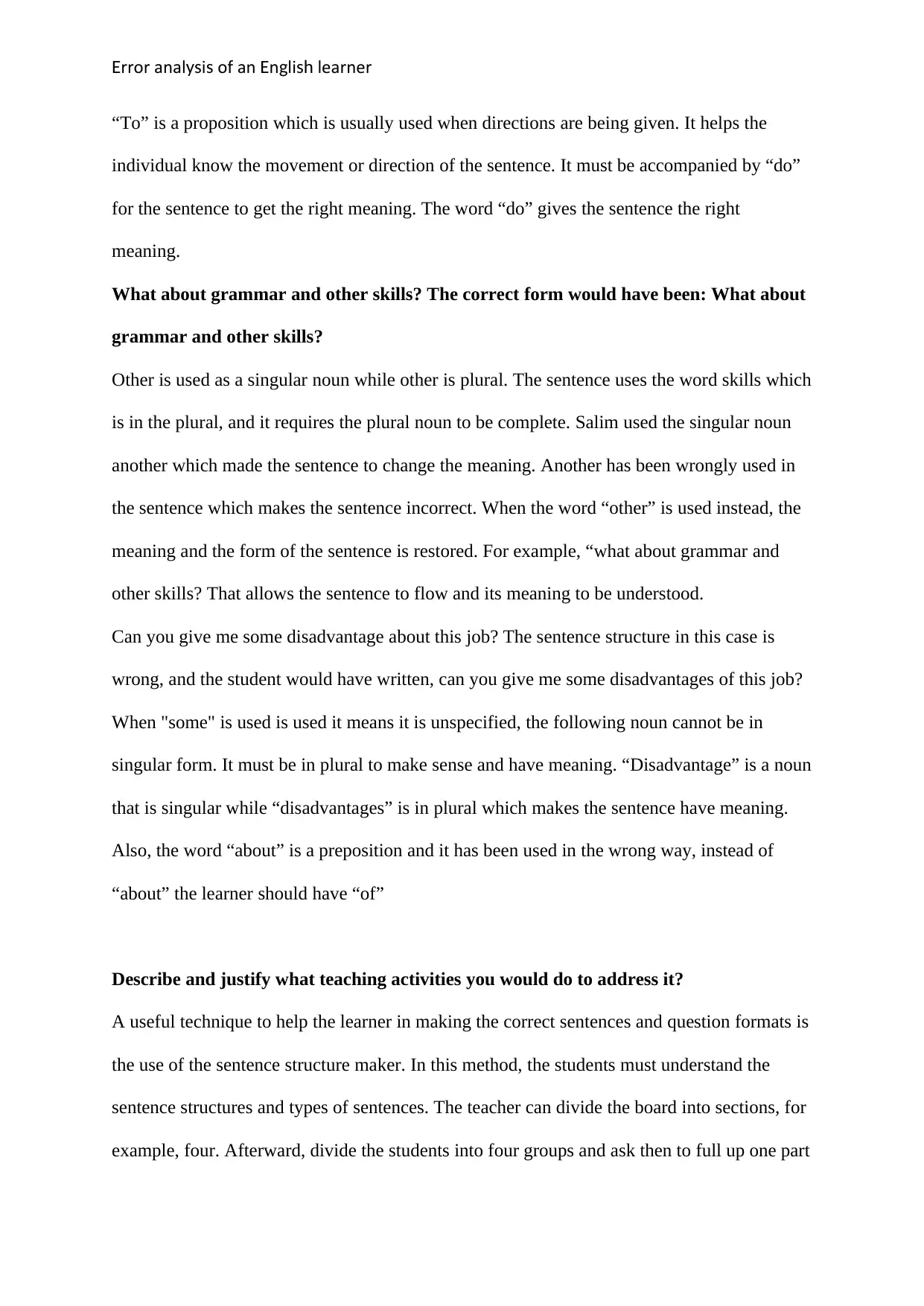
rror anal i o an n li learnerE ys s f E g sh
“To” is a proposition which is usually used when directions are being given. It helps the
individual know the movement or direction of the sentence. It must be accompanied by “do”
for the sentence to get the right meaning. The word “do” gives the sentence the right
meaning.
What about grammar and other skills? The correct form would have been: What about
grammar and other skills?
Other is used as a singular noun while other is plural. The sentence uses the word skills which
is in the plural, and it requires the plural noun to be complete. Salim used the singular noun
another which made the sentence to change the meaning. Another has been wrongly used in
the sentence which makes the sentence incorrect. When the word “other” is used instead, the
meaning and the form of the sentence is restored. For example, “what about grammar and
other skills? That allows the sentence to flow and its meaning to be understood.
Can you give me some disadvantage about this job? The sentence structure in this case is
wrong, and the student would have written, can you give me some disadvantages of this job?
When "some" is used is used it means it is unspecified, the following noun cannot be in
singular form. It must be in plural to make sense and have meaning. “Disadvantage” is a noun
that is singular while “disadvantages” is in plural which makes the sentence have meaning.
Also, the word “about” is a preposition and it has been used in the wrong way, instead of
“about” the learner should have “of”
Describe and justify what teaching activities you would do to address it?
A useful technique to help the learner in making the correct sentences and question formats is
the use of the sentence structure maker. In this method, the students must understand the
sentence structures and types of sentences. The teacher can divide the board into sections, for
example, four. Afterward, divide the students into four groups and ask then to full up one part
“To” is a proposition which is usually used when directions are being given. It helps the
individual know the movement or direction of the sentence. It must be accompanied by “do”
for the sentence to get the right meaning. The word “do” gives the sentence the right
meaning.
What about grammar and other skills? The correct form would have been: What about
grammar and other skills?
Other is used as a singular noun while other is plural. The sentence uses the word skills which
is in the plural, and it requires the plural noun to be complete. Salim used the singular noun
another which made the sentence to change the meaning. Another has been wrongly used in
the sentence which makes the sentence incorrect. When the word “other” is used instead, the
meaning and the form of the sentence is restored. For example, “what about grammar and
other skills? That allows the sentence to flow and its meaning to be understood.
Can you give me some disadvantage about this job? The sentence structure in this case is
wrong, and the student would have written, can you give me some disadvantages of this job?
When "some" is used is used it means it is unspecified, the following noun cannot be in
singular form. It must be in plural to make sense and have meaning. “Disadvantage” is a noun
that is singular while “disadvantages” is in plural which makes the sentence have meaning.
Also, the word “about” is a preposition and it has been used in the wrong way, instead of
“about” the learner should have “of”
Describe and justify what teaching activities you would do to address it?
A useful technique to help the learner in making the correct sentences and question formats is
the use of the sentence structure maker. In this method, the students must understand the
sentence structures and types of sentences. The teacher can divide the board into sections, for
example, four. Afterward, divide the students into four groups and ask then to full up one part
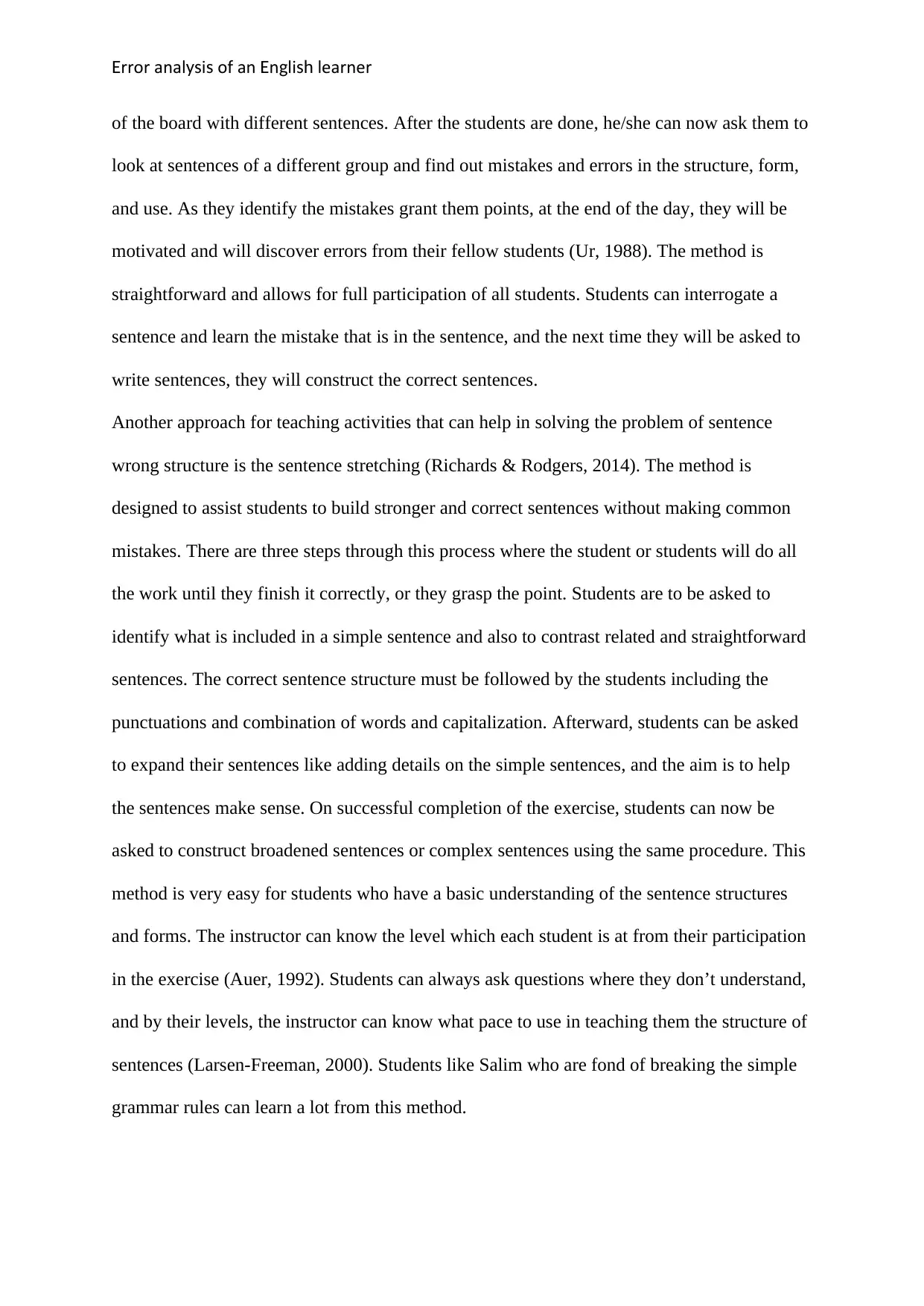
rror anal i o an n li learnerE ys s f E g sh
of the board with different sentences. After the students are done, he/she can now ask them to
look at sentences of a different group and find out mistakes and errors in the structure, form,
and use. As they identify the mistakes grant them points, at the end of the day, they will be
motivated and will discover errors from their fellow students (Ur, 1988). The method is
straightforward and allows for full participation of all students. Students can interrogate a
sentence and learn the mistake that is in the sentence, and the next time they will be asked to
write sentences, they will construct the correct sentences.
Another approach for teaching activities that can help in solving the problem of sentence
wrong structure is the sentence stretching (Richards & Rodgers, 2014). The method is
designed to assist students to build stronger and correct sentences without making common
mistakes. There are three steps through this process where the student or students will do all
the work until they finish it correctly, or they grasp the point. Students are to be asked to
identify what is included in a simple sentence and also to contrast related and straightforward
sentences. The correct sentence structure must be followed by the students including the
punctuations and combination of words and capitalization. Afterward, students can be asked
to expand their sentences like adding details on the simple sentences, and the aim is to help
the sentences make sense. On successful completion of the exercise, students can now be
asked to construct broadened sentences or complex sentences using the same procedure. This
method is very easy for students who have a basic understanding of the sentence structures
and forms. The instructor can know the level which each student is at from their participation
in the exercise (Auer, 1992). Students can always ask questions where they don’t understand,
and by their levels, the instructor can know what pace to use in teaching them the structure of
sentences (Larsen-Freeman, 2000). Students like Salim who are fond of breaking the simple
grammar rules can learn a lot from this method.
of the board with different sentences. After the students are done, he/she can now ask them to
look at sentences of a different group and find out mistakes and errors in the structure, form,
and use. As they identify the mistakes grant them points, at the end of the day, they will be
motivated and will discover errors from their fellow students (Ur, 1988). The method is
straightforward and allows for full participation of all students. Students can interrogate a
sentence and learn the mistake that is in the sentence, and the next time they will be asked to
write sentences, they will construct the correct sentences.
Another approach for teaching activities that can help in solving the problem of sentence
wrong structure is the sentence stretching (Richards & Rodgers, 2014). The method is
designed to assist students to build stronger and correct sentences without making common
mistakes. There are three steps through this process where the student or students will do all
the work until they finish it correctly, or they grasp the point. Students are to be asked to
identify what is included in a simple sentence and also to contrast related and straightforward
sentences. The correct sentence structure must be followed by the students including the
punctuations and combination of words and capitalization. Afterward, students can be asked
to expand their sentences like adding details on the simple sentences, and the aim is to help
the sentences make sense. On successful completion of the exercise, students can now be
asked to construct broadened sentences or complex sentences using the same procedure. This
method is very easy for students who have a basic understanding of the sentence structures
and forms. The instructor can know the level which each student is at from their participation
in the exercise (Auer, 1992). Students can always ask questions where they don’t understand,
and by their levels, the instructor can know what pace to use in teaching them the structure of
sentences (Larsen-Freeman, 2000). Students like Salim who are fond of breaking the simple
grammar rules can learn a lot from this method.
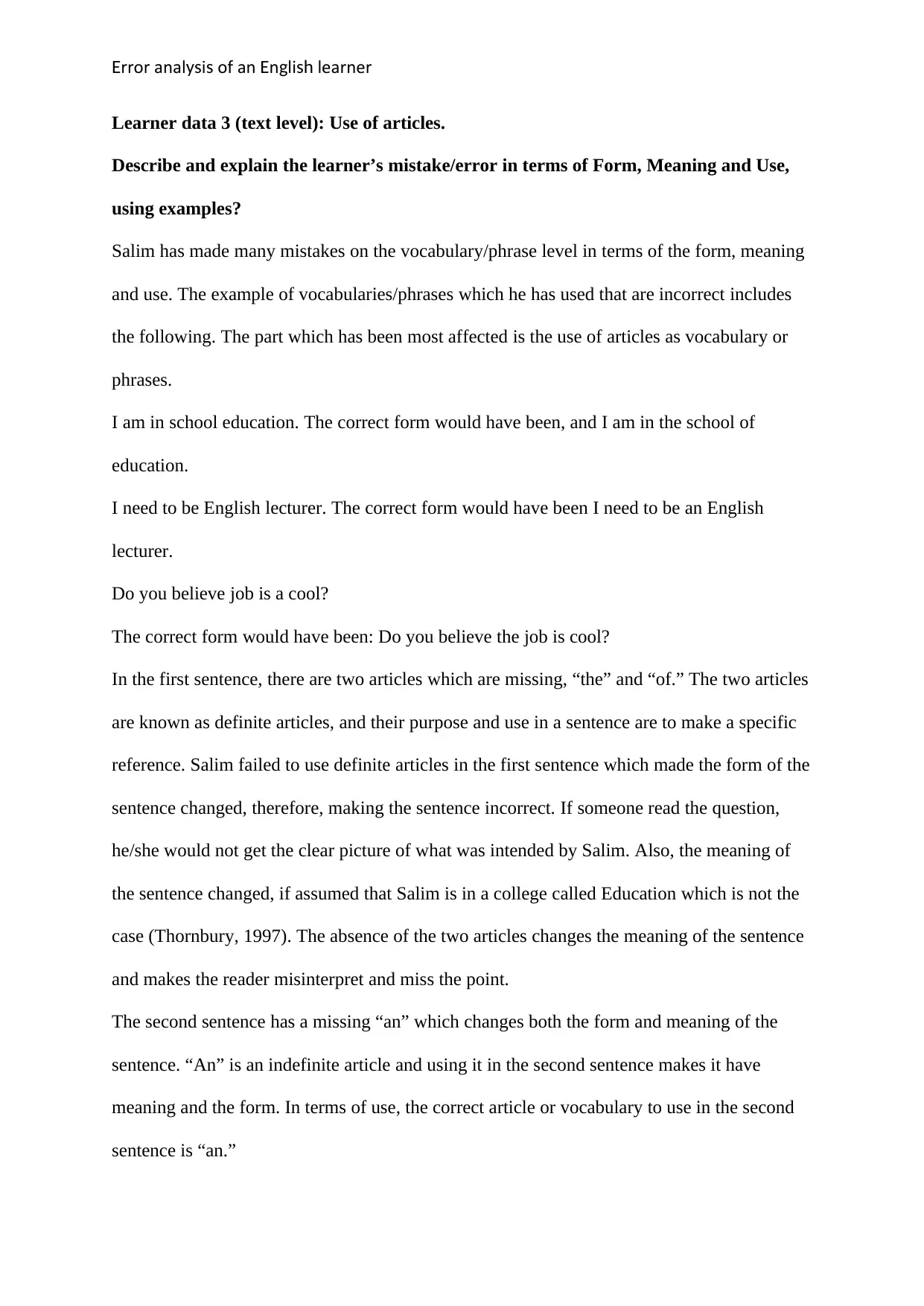
rror anal i o an n li learnerE ys s f E g sh
Learner data 3 (text level): Use of articles.
Describe and explain the learner’s mistake/error in terms of Form, Meaning and Use,
using examples?
Salim has made many mistakes on the vocabulary/phrase level in terms of the form, meaning
and use. The example of vocabularies/phrases which he has used that are incorrect includes
the following. The part which has been most affected is the use of articles as vocabulary or
phrases.
I am in school education. The correct form would have been, and I am in the school of
education.
I need to be English lecturer. The correct form would have been I need to be an English
lecturer.
Do you believe job is a cool?
The correct form would have been: Do you believe the job is cool?
In the first sentence, there are two articles which are missing, “the” and “of.” The two articles
are known as definite articles, and their purpose and use in a sentence are to make a specific
reference. Salim failed to use definite articles in the first sentence which made the form of the
sentence changed, therefore, making the sentence incorrect. If someone read the question,
he/she would not get the clear picture of what was intended by Salim. Also, the meaning of
the sentence changed, if assumed that Salim is in a college called Education which is not the
case (Thornbury, 1997). The absence of the two articles changes the meaning of the sentence
and makes the reader misinterpret and miss the point.
The second sentence has a missing “an” which changes both the form and meaning of the
sentence. “An” is an indefinite article and using it in the second sentence makes it have
meaning and the form. In terms of use, the correct article or vocabulary to use in the second
sentence is “an.”
Learner data 3 (text level): Use of articles.
Describe and explain the learner’s mistake/error in terms of Form, Meaning and Use,
using examples?
Salim has made many mistakes on the vocabulary/phrase level in terms of the form, meaning
and use. The example of vocabularies/phrases which he has used that are incorrect includes
the following. The part which has been most affected is the use of articles as vocabulary or
phrases.
I am in school education. The correct form would have been, and I am in the school of
education.
I need to be English lecturer. The correct form would have been I need to be an English
lecturer.
Do you believe job is a cool?
The correct form would have been: Do you believe the job is cool?
In the first sentence, there are two articles which are missing, “the” and “of.” The two articles
are known as definite articles, and their purpose and use in a sentence are to make a specific
reference. Salim failed to use definite articles in the first sentence which made the form of the
sentence changed, therefore, making the sentence incorrect. If someone read the question,
he/she would not get the clear picture of what was intended by Salim. Also, the meaning of
the sentence changed, if assumed that Salim is in a college called Education which is not the
case (Thornbury, 1997). The absence of the two articles changes the meaning of the sentence
and makes the reader misinterpret and miss the point.
The second sentence has a missing “an” which changes both the form and meaning of the
sentence. “An” is an indefinite article and using it in the second sentence makes it have
meaning and the form. In terms of use, the correct article or vocabulary to use in the second
sentence is “an.”
Secure Best Marks with AI Grader
Need help grading? Try our AI Grader for instant feedback on your assignments.
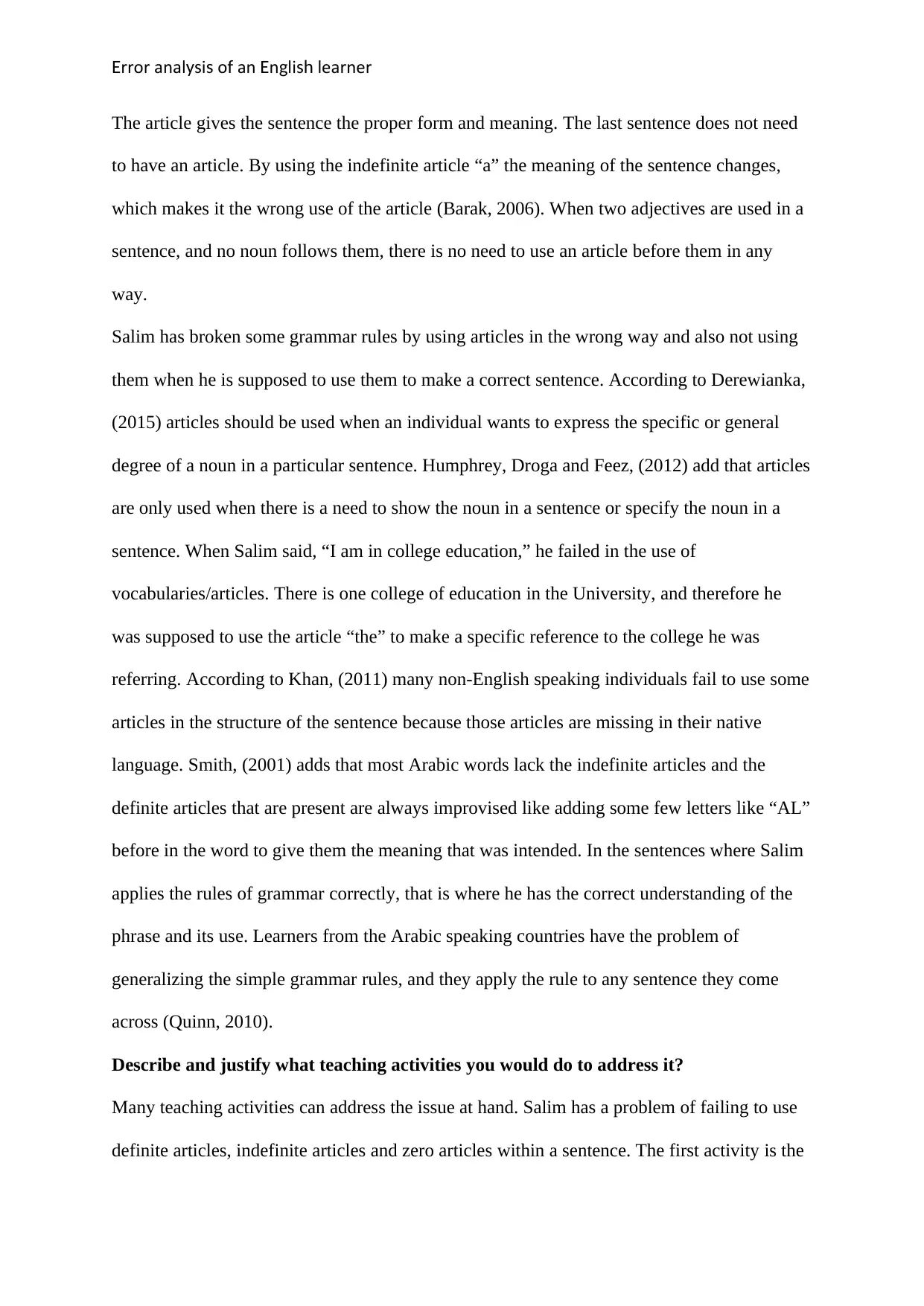
rror anal i o an n li learnerE ys s f E g sh
The article gives the sentence the proper form and meaning. The last sentence does not need
to have an article. By using the indefinite article “a” the meaning of the sentence changes,
which makes it the wrong use of the article (Barak, 2006). When two adjectives are used in a
sentence, and no noun follows them, there is no need to use an article before them in any
way.
Salim has broken some grammar rules by using articles in the wrong way and also not using
them when he is supposed to use them to make a correct sentence. According to Derewianka,
(2015) articles should be used when an individual wants to express the specific or general
degree of a noun in a particular sentence. Humphrey, Droga and Feez, (2012) add that articles
are only used when there is a need to show the noun in a sentence or specify the noun in a
sentence. When Salim said, “I am in college education,” he failed in the use of
vocabularies/articles. There is one college of education in the University, and therefore he
was supposed to use the article “the” to make a specific reference to the college he was
referring. According to Khan, (2011) many non-English speaking individuals fail to use some
articles in the structure of the sentence because those articles are missing in their native
language. Smith, (2001) adds that most Arabic words lack the indefinite articles and the
definite articles that are present are always improvised like adding some few letters like “AL”
before in the word to give them the meaning that was intended. In the sentences where Salim
applies the rules of grammar correctly, that is where he has the correct understanding of the
phrase and its use. Learners from the Arabic speaking countries have the problem of
generalizing the simple grammar rules, and they apply the rule to any sentence they come
across (Quinn, 2010).
Describe and justify what teaching activities you would do to address it?
Many teaching activities can address the issue at hand. Salim has a problem of failing to use
definite articles, indefinite articles and zero articles within a sentence. The first activity is the
The article gives the sentence the proper form and meaning. The last sentence does not need
to have an article. By using the indefinite article “a” the meaning of the sentence changes,
which makes it the wrong use of the article (Barak, 2006). When two adjectives are used in a
sentence, and no noun follows them, there is no need to use an article before them in any
way.
Salim has broken some grammar rules by using articles in the wrong way and also not using
them when he is supposed to use them to make a correct sentence. According to Derewianka,
(2015) articles should be used when an individual wants to express the specific or general
degree of a noun in a particular sentence. Humphrey, Droga and Feez, (2012) add that articles
are only used when there is a need to show the noun in a sentence or specify the noun in a
sentence. When Salim said, “I am in college education,” he failed in the use of
vocabularies/articles. There is one college of education in the University, and therefore he
was supposed to use the article “the” to make a specific reference to the college he was
referring. According to Khan, (2011) many non-English speaking individuals fail to use some
articles in the structure of the sentence because those articles are missing in their native
language. Smith, (2001) adds that most Arabic words lack the indefinite articles and the
definite articles that are present are always improvised like adding some few letters like “AL”
before in the word to give them the meaning that was intended. In the sentences where Salim
applies the rules of grammar correctly, that is where he has the correct understanding of the
phrase and its use. Learners from the Arabic speaking countries have the problem of
generalizing the simple grammar rules, and they apply the rule to any sentence they come
across (Quinn, 2010).
Describe and justify what teaching activities you would do to address it?
Many teaching activities can address the issue at hand. Salim has a problem of failing to use
definite articles, indefinite articles and zero articles within a sentence. The first activity is the
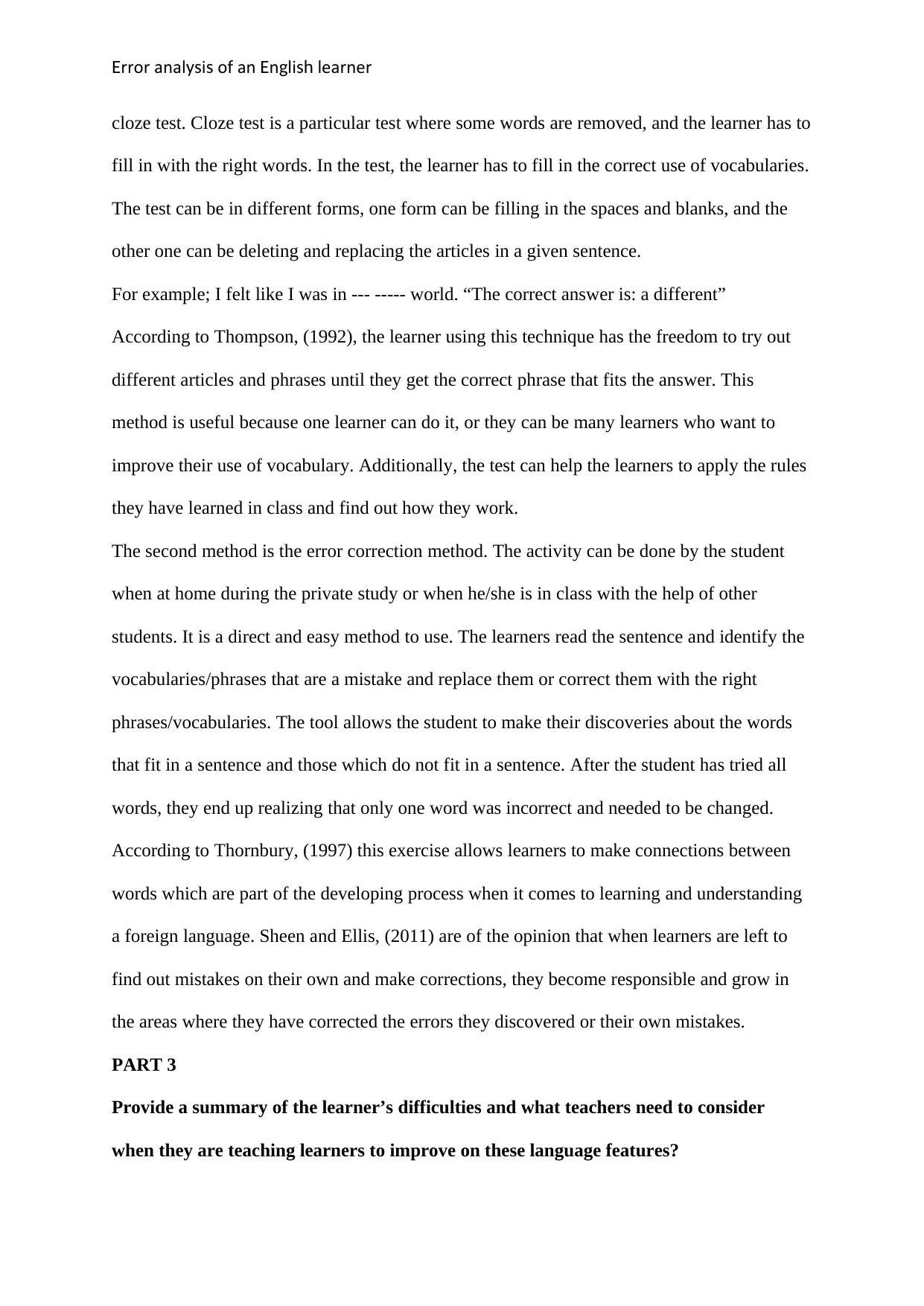
rror anal i o an n li learnerE ys s f E g sh
cloze test. Cloze test is a particular test where some words are removed, and the learner has to
fill in with the right words. In the test, the learner has to fill in the correct use of vocabularies.
The test can be in different forms, one form can be filling in the spaces and blanks, and the
other one can be deleting and replacing the articles in a given sentence.
For example; I felt like I was in --- ----- world. “The correct answer is: a different”
According to Thompson, (1992), the learner using this technique has the freedom to try out
different articles and phrases until they get the correct phrase that fits the answer. This
method is useful because one learner can do it, or they can be many learners who want to
improve their use of vocabulary. Additionally, the test can help the learners to apply the rules
they have learned in class and find out how they work.
The second method is the error correction method. The activity can be done by the student
when at home during the private study or when he/she is in class with the help of other
students. It is a direct and easy method to use. The learners read the sentence and identify the
vocabularies/phrases that are a mistake and replace them or correct them with the right
phrases/vocabularies. The tool allows the student to make their discoveries about the words
that fit in a sentence and those which do not fit in a sentence. After the student has tried all
words, they end up realizing that only one word was incorrect and needed to be changed.
According to Thornbury, (1997) this exercise allows learners to make connections between
words which are part of the developing process when it comes to learning and understanding
a foreign language. Sheen and Ellis, (2011) are of the opinion that when learners are left to
find out mistakes on their own and make corrections, they become responsible and grow in
the areas where they have corrected the errors they discovered or their own mistakes.
PART 3
Provide a summary of the learner’s difficulties and what teachers need to consider
when they are teaching learners to improve on these language features?
cloze test. Cloze test is a particular test where some words are removed, and the learner has to
fill in with the right words. In the test, the learner has to fill in the correct use of vocabularies.
The test can be in different forms, one form can be filling in the spaces and blanks, and the
other one can be deleting and replacing the articles in a given sentence.
For example; I felt like I was in --- ----- world. “The correct answer is: a different”
According to Thompson, (1992), the learner using this technique has the freedom to try out
different articles and phrases until they get the correct phrase that fits the answer. This
method is useful because one learner can do it, or they can be many learners who want to
improve their use of vocabulary. Additionally, the test can help the learners to apply the rules
they have learned in class and find out how they work.
The second method is the error correction method. The activity can be done by the student
when at home during the private study or when he/she is in class with the help of other
students. It is a direct and easy method to use. The learners read the sentence and identify the
vocabularies/phrases that are a mistake and replace them or correct them with the right
phrases/vocabularies. The tool allows the student to make their discoveries about the words
that fit in a sentence and those which do not fit in a sentence. After the student has tried all
words, they end up realizing that only one word was incorrect and needed to be changed.
According to Thornbury, (1997) this exercise allows learners to make connections between
words which are part of the developing process when it comes to learning and understanding
a foreign language. Sheen and Ellis, (2011) are of the opinion that when learners are left to
find out mistakes on their own and make corrections, they become responsible and grow in
the areas where they have corrected the errors they discovered or their own mistakes.
PART 3
Provide a summary of the learner’s difficulties and what teachers need to consider
when they are teaching learners to improve on these language features?
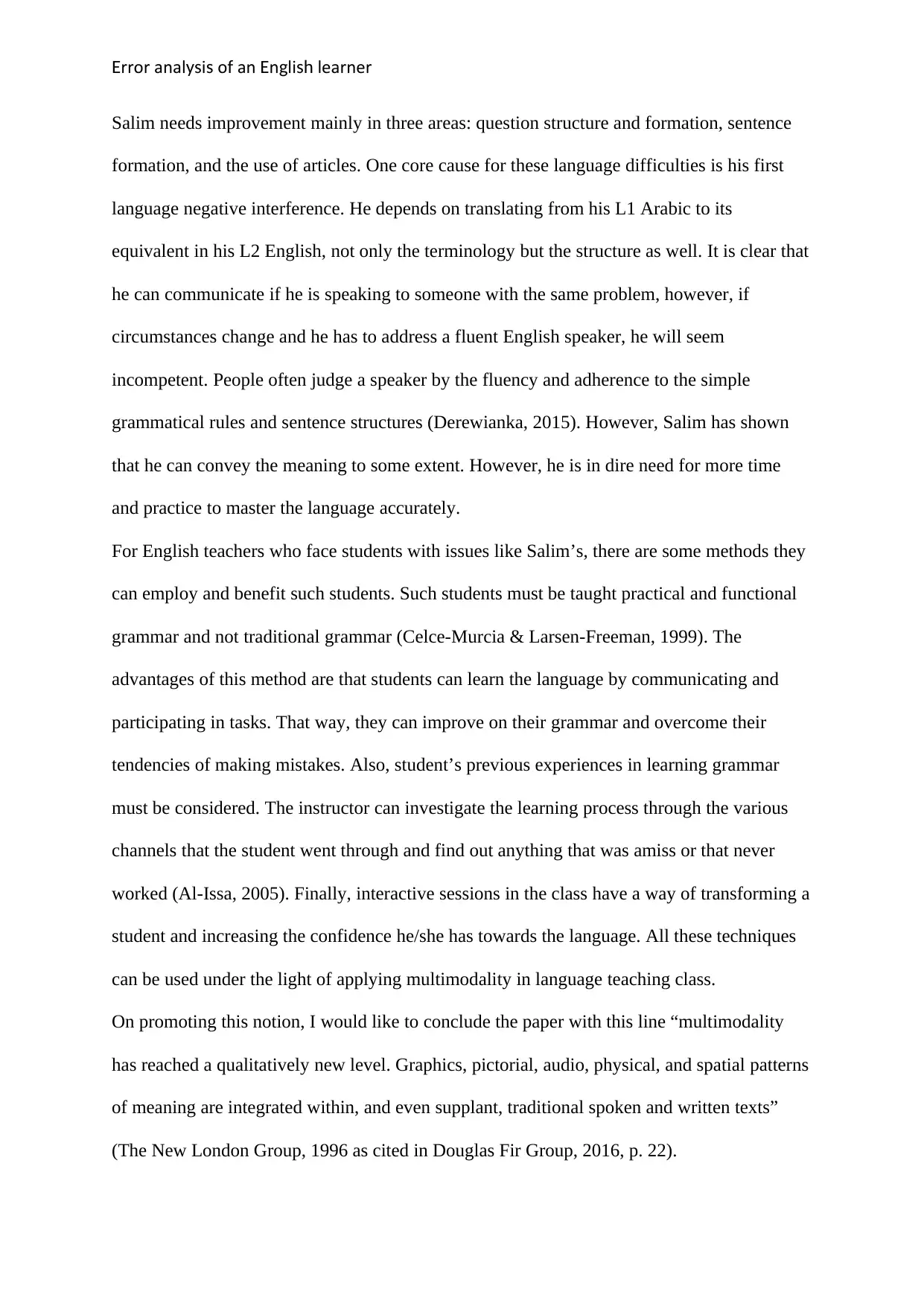
rror anal i o an n li learnerE ys s f E g sh
Salim needs improvement mainly in three areas: question structure and formation, sentence
formation, and the use of articles. One core cause for these language difficulties is his first
language negative interference. He depends on translating from his L1 Arabic to its
equivalent in his L2 English, not only the terminology but the structure as well. It is clear that
he can communicate if he is speaking to someone with the same problem, however, if
circumstances change and he has to address a fluent English speaker, he will seem
incompetent. People often judge a speaker by the fluency and adherence to the simple
grammatical rules and sentence structures (Derewianka, 2015). However, Salim has shown
that he can convey the meaning to some extent. However, he is in dire need for more time
and practice to master the language accurately.
For English teachers who face students with issues like Salim’s, there are some methods they
can employ and benefit such students. Such students must be taught practical and functional
grammar and not traditional grammar (Celce-Murcia & Larsen-Freeman, 1999). The
advantages of this method are that students can learn the language by communicating and
participating in tasks. That way, they can improve on their grammar and overcome their
tendencies of making mistakes. Also, student’s previous experiences in learning grammar
must be considered. The instructor can investigate the learning process through the various
channels that the student went through and find out anything that was amiss or that never
worked (Al-Issa, 2005). Finally, interactive sessions in the class have a way of transforming a
student and increasing the confidence he/she has towards the language. All these techniques
can be used under the light of applying multimodality in language teaching class.
On promoting this notion, I would like to conclude the paper with this line “multimodality
has reached a qualitatively new level. Graphics, pictorial, audio, physical, and spatial patterns
of meaning are integrated within, and even supplant, traditional spoken and written texts”
(The New London Group, 1996 as cited in Douglas Fir Group, 2016, p. 22).
Salim needs improvement mainly in three areas: question structure and formation, sentence
formation, and the use of articles. One core cause for these language difficulties is his first
language negative interference. He depends on translating from his L1 Arabic to its
equivalent in his L2 English, not only the terminology but the structure as well. It is clear that
he can communicate if he is speaking to someone with the same problem, however, if
circumstances change and he has to address a fluent English speaker, he will seem
incompetent. People often judge a speaker by the fluency and adherence to the simple
grammatical rules and sentence structures (Derewianka, 2015). However, Salim has shown
that he can convey the meaning to some extent. However, he is in dire need for more time
and practice to master the language accurately.
For English teachers who face students with issues like Salim’s, there are some methods they
can employ and benefit such students. Such students must be taught practical and functional
grammar and not traditional grammar (Celce-Murcia & Larsen-Freeman, 1999). The
advantages of this method are that students can learn the language by communicating and
participating in tasks. That way, they can improve on their grammar and overcome their
tendencies of making mistakes. Also, student’s previous experiences in learning grammar
must be considered. The instructor can investigate the learning process through the various
channels that the student went through and find out anything that was amiss or that never
worked (Al-Issa, 2005). Finally, interactive sessions in the class have a way of transforming a
student and increasing the confidence he/she has towards the language. All these techniques
can be used under the light of applying multimodality in language teaching class.
On promoting this notion, I would like to conclude the paper with this line “multimodality
has reached a qualitatively new level. Graphics, pictorial, audio, physical, and spatial patterns
of meaning are integrated within, and even supplant, traditional spoken and written texts”
(The New London Group, 1996 as cited in Douglas Fir Group, 2016, p. 22).
Paraphrase This Document
Need a fresh take? Get an instant paraphrase of this document with our AI Paraphraser

rror anal i o an n li learnerE ys s f E g sh
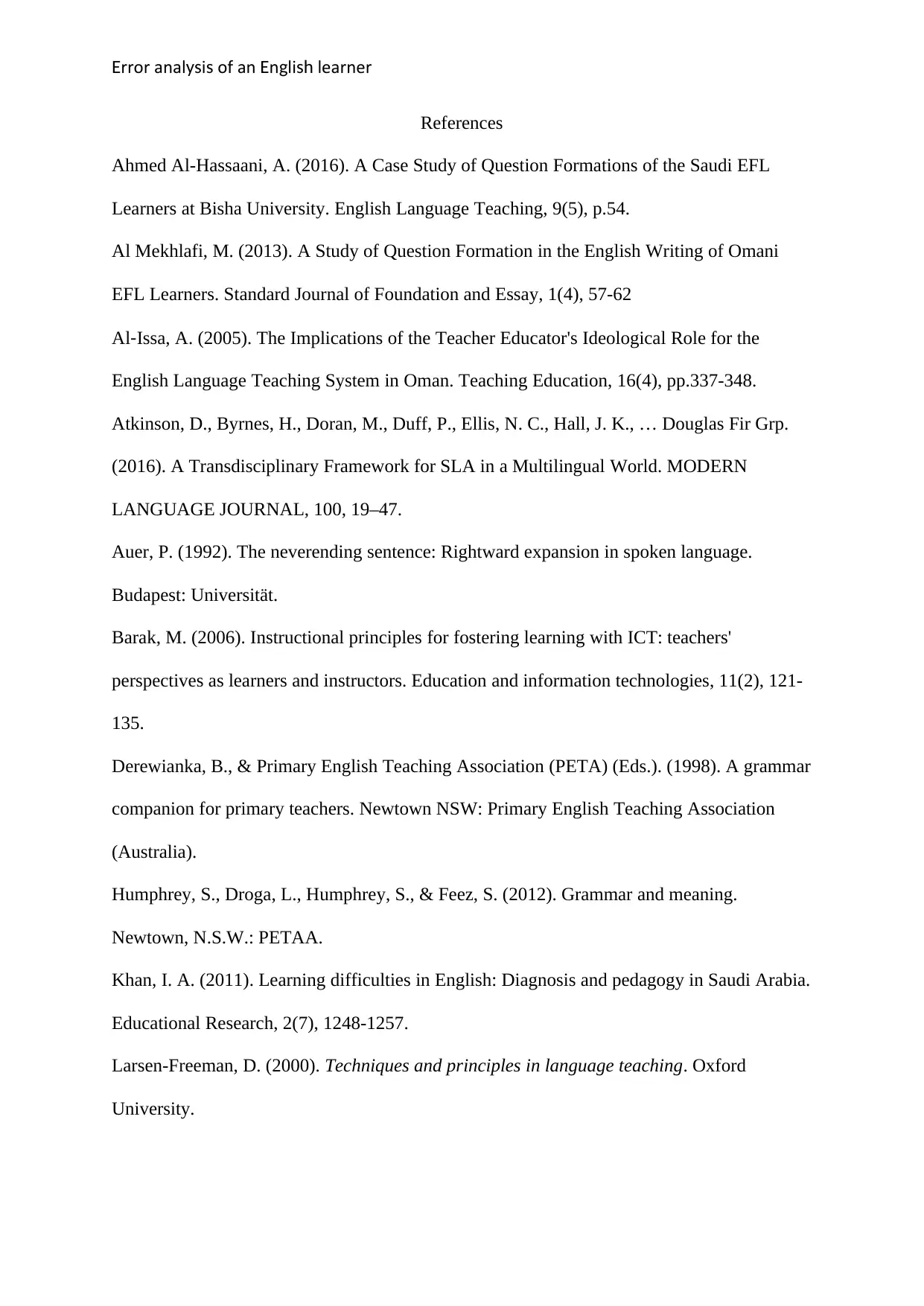
rror anal i o an n li learnerE ys s f E g sh
References
Ahmed Al-Hassaani, A. (2016). A Case Study of Question Formations of the Saudi EFL
Learners at Bisha University. English Language Teaching, 9(5), p.54.
Al Mekhlafi, M. (2013). A Study of Question Formation in the English Writing of Omani
EFL Learners. Standard Journal of Foundation and Essay, 1(4), 57-62
Al‐Issa, A. (2005). The Implications of the Teacher Educator's Ideological Role for the
English Language Teaching System in Oman. Teaching Education, 16(4), pp.337-348.
Atkinson, D., Byrnes, H., Doran, M., Duff, P., Ellis, N. C., Hall, J. K., … Douglas Fir Grp.
(2016). A Transdisciplinary Framework for SLA in a Multilingual World. MODERN
LANGUAGE JOURNAL, 100, 19–47.
Auer, P. (1992). The neverending sentence: Rightward expansion in spoken language.
Budapest: Universität.
Barak, M. (2006). Instructional principles for fostering learning with ICT: teachers'
perspectives as learners and instructors. Education and information technologies, 11(2), 121-
135.
Derewianka, B., & Primary English Teaching Association (PETA) (Eds.). (1998). A grammar
companion for primary teachers. Newtown NSW: Primary English Teaching Association
(Australia).
Humphrey, S., Droga, L., Humphrey, S., & Feez, S. (2012). Grammar and meaning.
Newtown, N.S.W.: PETAA.
Khan, I. A. (2011). Learning difficulties in English: Diagnosis and pedagogy in Saudi Arabia.
Educational Research, 2(7), 1248-1257.
Larsen-Freeman, D. (2000). Techniques and principles in language teaching. Oxford
University.
References
Ahmed Al-Hassaani, A. (2016). A Case Study of Question Formations of the Saudi EFL
Learners at Bisha University. English Language Teaching, 9(5), p.54.
Al Mekhlafi, M. (2013). A Study of Question Formation in the English Writing of Omani
EFL Learners. Standard Journal of Foundation and Essay, 1(4), 57-62
Al‐Issa, A. (2005). The Implications of the Teacher Educator's Ideological Role for the
English Language Teaching System in Oman. Teaching Education, 16(4), pp.337-348.
Atkinson, D., Byrnes, H., Doran, M., Duff, P., Ellis, N. C., Hall, J. K., … Douglas Fir Grp.
(2016). A Transdisciplinary Framework for SLA in a Multilingual World. MODERN
LANGUAGE JOURNAL, 100, 19–47.
Auer, P. (1992). The neverending sentence: Rightward expansion in spoken language.
Budapest: Universität.
Barak, M. (2006). Instructional principles for fostering learning with ICT: teachers'
perspectives as learners and instructors. Education and information technologies, 11(2), 121-
135.
Derewianka, B., & Primary English Teaching Association (PETA) (Eds.). (1998). A grammar
companion for primary teachers. Newtown NSW: Primary English Teaching Association
(Australia).
Humphrey, S., Droga, L., Humphrey, S., & Feez, S. (2012). Grammar and meaning.
Newtown, N.S.W.: PETAA.
Khan, I. A. (2011). Learning difficulties in English: Diagnosis and pedagogy in Saudi Arabia.
Educational Research, 2(7), 1248-1257.
Larsen-Freeman, D. (2000). Techniques and principles in language teaching. Oxford
University.
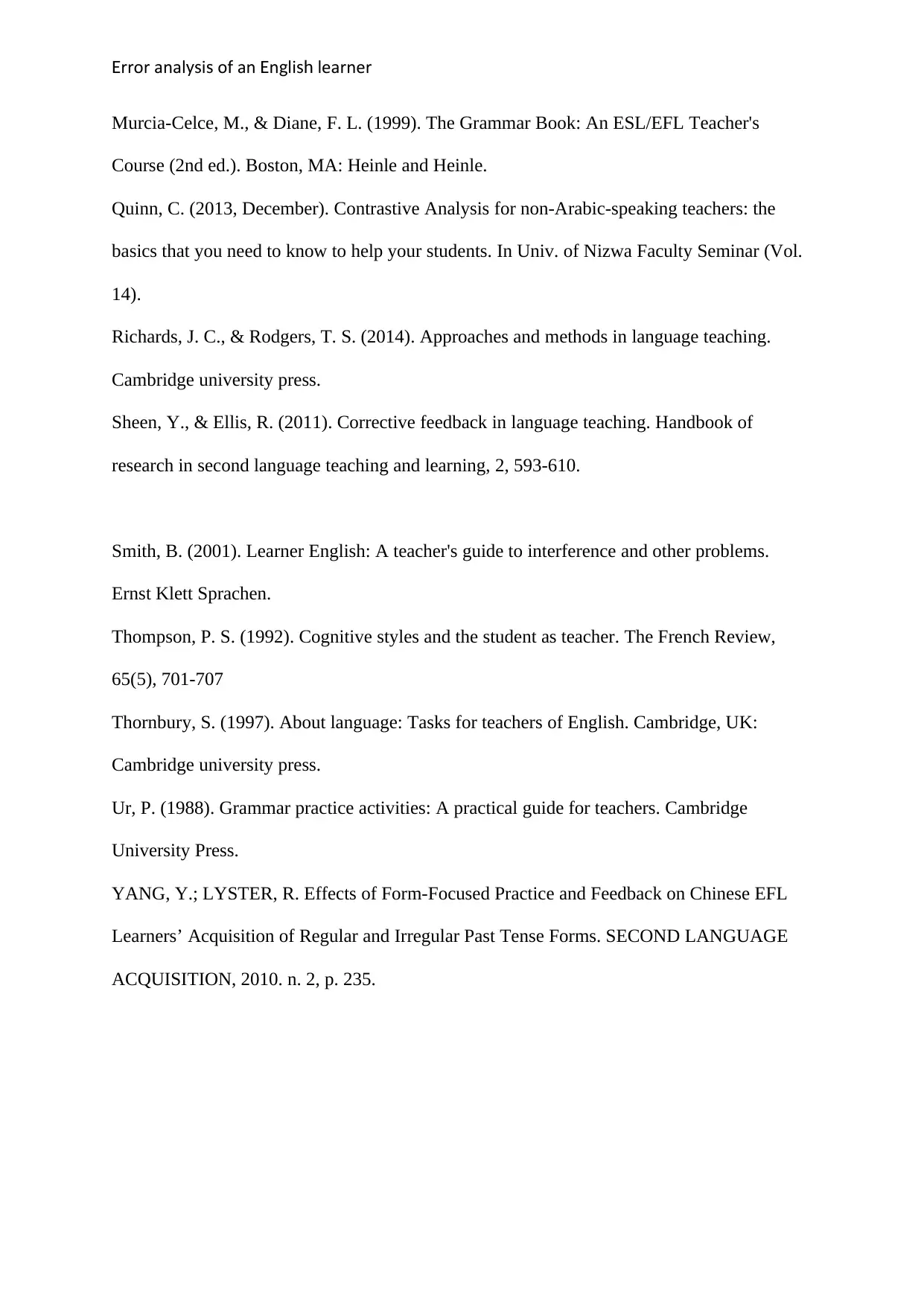
rror anal i o an n li learnerE ys s f E g sh
Murcia-Celce, M., & Diane, F. L. (1999). The Grammar Book: An ESL/EFL Teacher's
Course (2nd ed.). Boston, MA: Heinle and Heinle.
Quinn, C. (2013, December). Contrastive Analysis for non-Arabic-speaking teachers: the
basics that you need to know to help your students. In Univ. of Nizwa Faculty Seminar (Vol.
14).
Richards, J. C., & Rodgers, T. S. (2014). Approaches and methods in language teaching.
Cambridge university press.
Sheen, Y., & Ellis, R. (2011). Corrective feedback in language teaching. Handbook of
research in second language teaching and learning, 2, 593-610.
Smith, B. (2001). Learner English: A teacher's guide to interference and other problems.
Ernst Klett Sprachen.
Thompson, P. S. (1992). Cognitive styles and the student as teacher. The French Review,
65(5), 701-707
Thornbury, S. (1997). About language: Tasks for teachers of English. Cambridge, UK:
Cambridge university press.
Ur, P. (1988). Grammar practice activities: A practical guide for teachers. Cambridge
University Press.
YANG, Y.; LYSTER, R. Effects of Form-Focused Practice and Feedback on Chinese EFL
Learners’ Acquisition of Regular and Irregular Past Tense Forms. SECOND LANGUAGE
ACQUISITION, 2010. n. 2, p. 235.
Murcia-Celce, M., & Diane, F. L. (1999). The Grammar Book: An ESL/EFL Teacher's
Course (2nd ed.). Boston, MA: Heinle and Heinle.
Quinn, C. (2013, December). Contrastive Analysis for non-Arabic-speaking teachers: the
basics that you need to know to help your students. In Univ. of Nizwa Faculty Seminar (Vol.
14).
Richards, J. C., & Rodgers, T. S. (2014). Approaches and methods in language teaching.
Cambridge university press.
Sheen, Y., & Ellis, R. (2011). Corrective feedback in language teaching. Handbook of
research in second language teaching and learning, 2, 593-610.
Smith, B. (2001). Learner English: A teacher's guide to interference and other problems.
Ernst Klett Sprachen.
Thompson, P. S. (1992). Cognitive styles and the student as teacher. The French Review,
65(5), 701-707
Thornbury, S. (1997). About language: Tasks for teachers of English. Cambridge, UK:
Cambridge university press.
Ur, P. (1988). Grammar practice activities: A practical guide for teachers. Cambridge
University Press.
YANG, Y.; LYSTER, R. Effects of Form-Focused Practice and Feedback on Chinese EFL
Learners’ Acquisition of Regular and Irregular Past Tense Forms. SECOND LANGUAGE
ACQUISITION, 2010. n. 2, p. 235.
1 out of 16
Related Documents
Your All-in-One AI-Powered Toolkit for Academic Success.
+13062052269
info@desklib.com
Available 24*7 on WhatsApp / Email
![[object Object]](/_next/static/media/star-bottom.7253800d.svg)
Unlock your academic potential
© 2024 | Zucol Services PVT LTD | All rights reserved.




